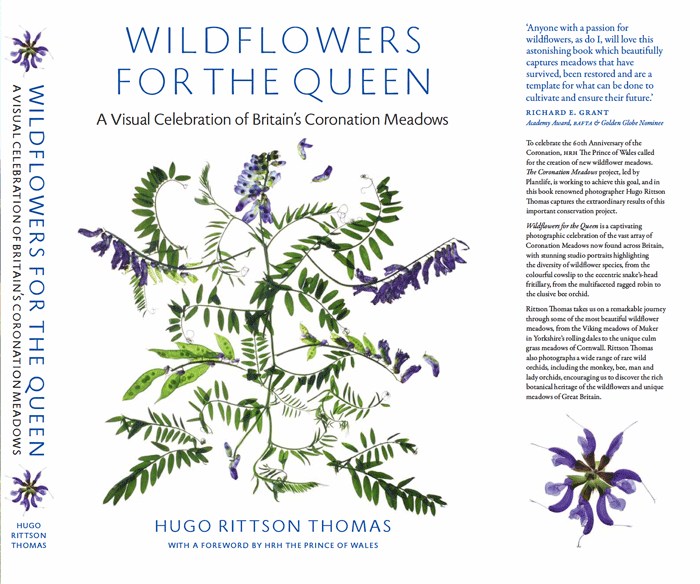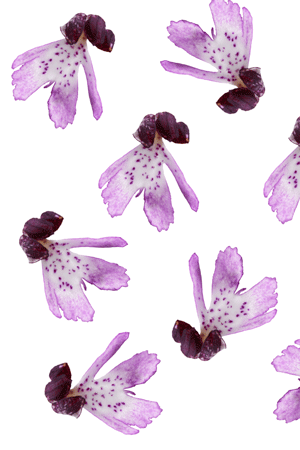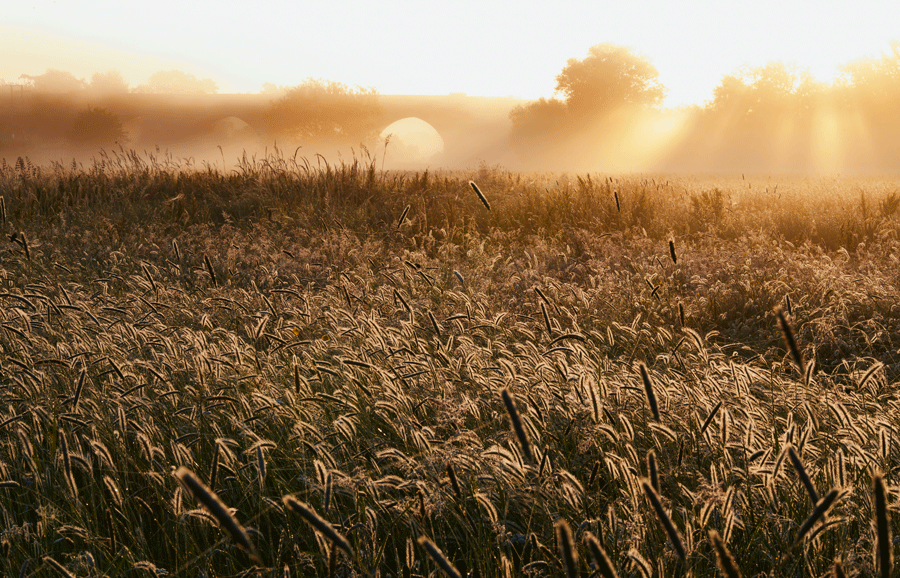Wildflowers for The Queen – Review
In his new book, “Wildflowers for the Queen – a celebration of wildflower meadows“, Hugo Rittson Thomas celebrates a very different cultural icon – our precious wildflower meadows.
The book, published in partnership with conservation charity Plantlife and with a foreword by their patron HRH The Prince of Wales, takes the reader on a journey to explore the unsung beauty and diversity of wildflower meadows and the achievements of the Coronation Meadows project, established by HRH The Prince of Wales in 2013.
The hardback, large-format art title features a range of essays from high-profile contributors, including the broadcaster and gardener, Alan Titchmarsh who is Plantlife President; art dealer Philip Mould, whose essay explores the relationship between wildflower meadows and art; landscape designer Dan Pearson and screenwriter and actor Julian Fellowes.
 HRH The Prince of Wales explains that the idea of the Coronation Meadows project is a simple one: “To find the best surviving meadow in each county and use seed from that meadow to create a new one. Many of those wonderful meadows are now captured in this book,” he says. The meadow at Highgrove is featured in the book – created over 30 years ago, it was the brainchild of the Prince and Dame Miriam Rothschild who sowed a mix of over 100 species of wildflowers typical of Gloucestershire to replicate the old meadows lost over time. It is indeed fitting that Prince Charles should be the driving force behind the project which commemorates the Queen’s Coronation nearly 70 years ago.
HRH The Prince of Wales explains that the idea of the Coronation Meadows project is a simple one: “To find the best surviving meadow in each county and use seed from that meadow to create a new one. Many of those wonderful meadows are now captured in this book,” he says. The meadow at Highgrove is featured in the book – created over 30 years ago, it was the brainchild of the Prince and Dame Miriam Rothschild who sowed a mix of over 100 species of wildflowers typical of Gloucestershire to replicate the old meadows lost over time. It is indeed fitting that Prince Charles should be the driving force behind the project which commemorates the Queen’s Coronation nearly 70 years ago.
The book contains photographs taken over the course of a year and features 19 meadows (of which 14 are Coronation Meadows) in stunning locations including Blenheim Palace, Chatsworth and Highclere Castle. Rittson Thomas was granted access by The Queen to Sandringham, whose meadow is a particularly magical example of wildflowers.
Also featured in the book are wonderful meadows we see about the countryside, taking us from the Viking meadows of Muker, in the Yorkshire Dales to the Cornish unique culm grass meadows of Cornwall. The author has an artistic eye that allows us to look at these meadows anew, with photography focusing on the wonderful patterns we find in our meadows, the textures, shapes and colours and the variety of wildflowers.
 This is a beautifully illustrated book, perfectly capturing the rich diversity of our native meadows, includes a wide range of orchids such as the lady and bee orchids. There are other stars too such as the Snake’s Head Fritillary, Meadow Crane’s-bill, Common Bird’s foot Trefoil and Meadow Clary.
This is a beautifully illustrated book, perfectly capturing the rich diversity of our native meadows, includes a wide range of orchids such as the lady and bee orchids. There are other stars too such as the Snake’s Head Fritillary, Meadow Crane’s-bill, Common Bird’s foot Trefoil and Meadow Clary.
The various essays offer very personal insights into what meadows mean to the individual, while the descriptions of the meadows featured are comprehensive and detailed. However, it is the plants who star and there are some absolutely superb images that will be the delight of both plant enthusiast and amateur alike. Each plant is covered extensively and in detail in the large number of studio portraits where the author treats each botanical species with the same regard as the high-profile photographic subjects he is well known for.
As the author points out in the Introduction, the book is designed to make ‘the invisible visible’ and to celebrate the rich botanical heritage of the wildflowers and unique meadows of Britain with their exotic and often charming names.
In fact, the whole book is a total joy to read and as I write this review during a lockdown, the images across its pages bring a sense of calm wellbeing. I was delighted to see that Rittson Thomas has included the Muker Meadows, a landscape well known to me, with its rich limestone soils beside the River Swale. The pictures of this wonderful meadow and its various plants filled me with happy memories of times spent looking across this upland meadow.
The book also explores the urgent question about conservation and biodiversity in Britain. Meadows are one of the UK’s most species-rich habitats supporting nearly 800 types of flowers and plants. Surviving fragments of flower-rich meadows and pastures only account for 1% of UK land and we have lost an alarming 7.5 million acres since the 1930s. It is to be hoped that Rittson Thomas’ book stimulates greater interest in these precious habitats
 Rittson Thomas (pictured left) explains that the premise and aim of the book is to celebrate the rich botanical heritage of the wild flowers and unique meadows of England: “…with their exotic and often charming names – like creeping lady’s tresses (Goodyera repens) or snake’s head fritillary (Fritillaria meleagris) and to elevate them not only as the stars of the show, but also as valuable and irreplaceable forms of life on our green planet. My hope is that the book will inspire others to be enthusiastic about wildflowers and even visit the meadows for themselves.”
Rittson Thomas (pictured left) explains that the premise and aim of the book is to celebrate the rich botanical heritage of the wild flowers and unique meadows of England: “…with their exotic and often charming names – like creeping lady’s tresses (Goodyera repens) or snake’s head fritillary (Fritillaria meleagris) and to elevate them not only as the stars of the show, but also as valuable and irreplaceable forms of life on our green planet. My hope is that the book will inspire others to be enthusiastic about wildflowers and even visit the meadows for themselves.”
Hugo Rittson Thomas is a British portrait photographer who has written three previous books including the Secret Gardens of the Cotswolds. He photographed Her Majesty The Queen, The Duke of Cambridge and The Duchess of Cornwall for his book The Queen’s People. Other notable portraits include the Dalai Lama in Dharamsala.
The Coronation Meadows project is led by Plantlife with the Wildlife Trusts and the Rare Breeds Survival Trust and has succeeded in creating 90 new wildflower meadows across the UK and highlighting the devastating loss of these landscapes.
“Wildflowers for the Queen – a celebration of wildflower meadows“, by fine-art photographer, Hugo Rittson Thomas, is published in large art format by Wildflower Press at £50.00.
All images are strictly © of Hugo Rittson Thomas and the Publishers.



